Jennifer Barclay's Blog, page 11
December 4, 2013
Alone (almost) at the Acropolis - Atmospheric Athens

'I can't believe there's nobody here.'
My cousin and my mum came to Athens for the first time this week, arriving at the end of November for my birthday. Although - except for the first day, my birthday - the weather was cold and the sky grey, they were amazed how quiet it was. No queues, no crowds.
'It's so cheap here. And I didn't expect people to be so friendly in a big city.'
We've been lucky - at the last minute I found the airbnb website, and a whole apartment to rent for less than 200 euros for the week. I'd worried that it might be too far away from the centre, but it's been an easy half hour walk to the heart of Athens, via the ancient stadium and national gardens and Temple of Zeus.
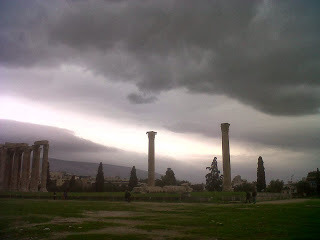
We practically had the Acropolis to ourselves. The ancient agora - where you could say democracy began - was deserted. I love seeing places afresh through someone else's eyes. My mum said she never expected so much green space around the Acropolis, so much of the ancient city uncluttered by modern buildings.
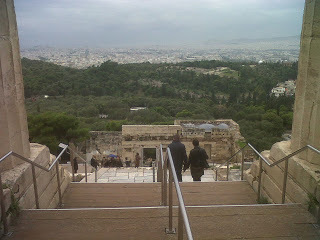
So it was raining... 'It's a UNESCO world heritage site - you'd think there would be people here all the time,' said my cousin. Much better to come for a city break late in the year than in the heat of summer.
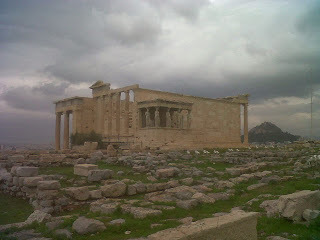
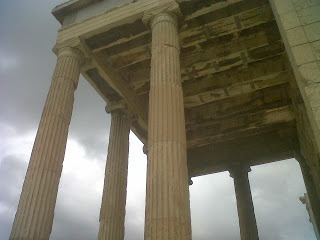
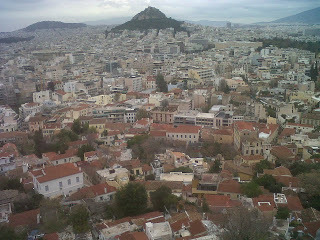
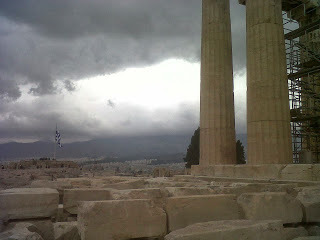
And when it's raining, sometimes you just have to duck into a cafe... We had mezes of winter salad and hummus and marinated anchovies with raki to drink, for 16 euros at the Ivis cafe in Psirri.
I'd never been to Pangrati until I rented this apartment, but it's a great neighbourhood with food shops, bars and cafes. We ate out three nights at To Mavro Provato (The Black Sheep); on our last night we ate a salad, big prawns and fennel in ouzo, prawn linguine, and the superb signature dish of tender lamb wrapped in paper with lots of herbs and cheese and baked in the oven - all for 48 euros including wine for the three of us. But we also ate very good food for a mere 22 euros for three, including wine, at Dionysus, 'The Quick Greek', just around the corner.

And I took mum to my favourite bakery on Sarri St. 'You never think of Greek bakeries being so good, but these are as wonderful as the ones in France.'
I'm not exclusively gallivanting in Athens this week - I'm also visiting the lovely people at EmBIO clinic every couple of days for blood test and scan while I do the pre-IVF meds. Jabbed myself in belly with needles a record five times yesterday. But yesterday was reported to be responding 'very well, excellent' (gold star!), and today: no injections! And tomorrow I get a nice long sleep while they take out some eggs and see how they look...
Published on December 04, 2013 13:35
November 26, 2013
Unplanned Adventures in Sitia, Crete - Part Two
The next morning, I chickened out of hiring the last surviving Minoan car, and we headed for the hills, Lisa and I. Fairly soon, I was pleased I'd decided not to drive.

Like the outskirts of most towns, I supposed, it was scrappy with old bits of machinery, run-down or abandoned houses cheek by jowl with expensive new ones in different styles and colours. It was an uninspiring morning weather-wise too. Then I saw an intriguing sign for Tripitos – and turned off to a promontory to wander the ruins of an ancient Hellenistic city. Unlike at Petras, there are no signs, but clear remains of houses, and green boulders facing out to see towards a far island. I'd probably have missed it if I'd been driving.



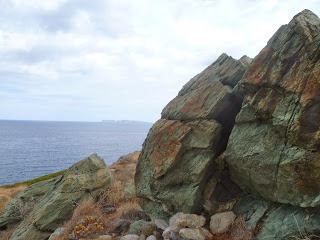
I’d entertained ideas of getting to a monastery way down the coast, but now I needed to escape the fast traffic and barking guard-dogs at the roadside. So instead we headed uphill into the hinterland where the traffic was thinner and there was birdsong, olive trees, views of cultivated fields below. I had no idea where I was going, but I liked the look of the mountains. And the sun was coming out. It was hot walking miles uphill on tarmac. But a workman confirmed there was a village further up. We made it to Roussa Ekklisia at noon.

The first kafeneion and the restaurant were shut, but I spotted a taverna with an open door and asked for lemonade and water. ‘I don't have water,’ said the friendly lady. ‘Only from the spring!’ she added, pointing outside. Beside us was a beautiful stone fountain with Turkish writing, and spring water gushing from it. Lisa got a bowl of Roussa’s finest. Perked up, we continued.


I didn't mean to continue walking so far, but the paths through the woods past Roussa were beautiful.
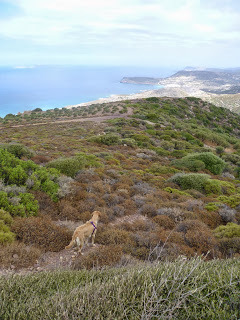
Two hours later we were at a little church, maybe called Stavros. There was something very special about that little white church I'd seen high on a hillside in the middle of nowhere. Tired and hungry but exhilarated, I took off my shoes, lay down and listened to the only sounds: rushing spring water and the odd froggy squawk of birds of prey up above. Inside the church were the most amazingly beautiful paintings.
I didn’t have a good enough map to know exactly where we were, or how far away the next village was. I wanted to keep going, but we didn’t have food. I wanted to stay up in these hills. I was so pleased I'd come here.




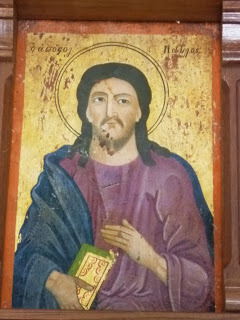

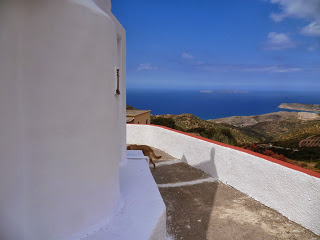


... More of the Cretan adventure soon!

Like the outskirts of most towns, I supposed, it was scrappy with old bits of machinery, run-down or abandoned houses cheek by jowl with expensive new ones in different styles and colours. It was an uninspiring morning weather-wise too. Then I saw an intriguing sign for Tripitos – and turned off to a promontory to wander the ruins of an ancient Hellenistic city. Unlike at Petras, there are no signs, but clear remains of houses, and green boulders facing out to see towards a far island. I'd probably have missed it if I'd been driving.




I’d entertained ideas of getting to a monastery way down the coast, but now I needed to escape the fast traffic and barking guard-dogs at the roadside. So instead we headed uphill into the hinterland where the traffic was thinner and there was birdsong, olive trees, views of cultivated fields below. I had no idea where I was going, but I liked the look of the mountains. And the sun was coming out. It was hot walking miles uphill on tarmac. But a workman confirmed there was a village further up. We made it to Roussa Ekklisia at noon.

The first kafeneion and the restaurant were shut, but I spotted a taverna with an open door and asked for lemonade and water. ‘I don't have water,’ said the friendly lady. ‘Only from the spring!’ she added, pointing outside. Beside us was a beautiful stone fountain with Turkish writing, and spring water gushing from it. Lisa got a bowl of Roussa’s finest. Perked up, we continued.


I didn't mean to continue walking so far, but the paths through the woods past Roussa were beautiful.

Two hours later we were at a little church, maybe called Stavros. There was something very special about that little white church I'd seen high on a hillside in the middle of nowhere. Tired and hungry but exhilarated, I took off my shoes, lay down and listened to the only sounds: rushing spring water and the odd froggy squawk of birds of prey up above. Inside the church were the most amazingly beautiful paintings.
I didn’t have a good enough map to know exactly where we were, or how far away the next village was. I wanted to keep going, but we didn’t have food. I wanted to stay up in these hills. I was so pleased I'd come here.









... More of the Cretan adventure soon!
Published on November 26, 2013 03:32
November 24, 2013
Late September in Sitia, Crete - Part One
In late September I had to travel to eastern Crete for work, taking the ferry from Rhodes to Sitia. Hours before I was due to leave, Lisa developed a problem with her ear and needed to see the vet in Rhodes. So I took her along.
Since none of the taxis at the port in Rhodes would take a dog (or maybe they didn't like the look of me...), I walked with my backpack – plus Lisa’s dog food, as if she was going to eat any of that stuff – across the old town and all the way to the vet’s.
It was just as well: he found a length of sharp dry grass deep piercing her ear drum. He put her to sleep while he buried his arm in her ear to pluck it out. His office managed to book us a cab that would take me and a very groggy dog back to the port. She was still sleepy when the ferry arrived, and I had to carry her on board and up all the steps to the top deck dogs’ accommodation. The vet had just weighed her: twenty kilos.
The Preveli reminded me how lucky we are to have the good ship Diagoras. No cosy couches here; and the dogs’ pens were cold and noisy and far away from human contact. There were just two dogs, shaky and shivery… It was hard to leave Lisa there for the night. I wished I could put her back to sleep.
But it was warm and sunny when we arrived, early morning, in Sitia.

My work in Crete involved taking the bus straight to Ierapetra on the south coast. But according to the bus company, there was no way that was going to happen unless I bought a cage for Lisa and put her in the hold with the luggage. There are indeed days when Lisa deserves to be locked up in a cage…. But not when she was on antibiotics and painkillers for a healing ear drum, had just endured a cold night on the Preveli and been welcomed to Sitia by some hard-looking canines.
The Preveli was going back to Rhodes that afternoon. I had a few hours to decide whether to try staying in Sitia for three days, or go straight back, another twelve hours on the ship and all for nothing. Finally a car rental office called Minoan (I wondered if they were authentic Minoan cars?) came to our rescue.
When I walked into his office, weary from hefting my backpack to the bus station and all around town after a fairly sleepless night, Michalis smiled at Lisa and she jumped up and put her two front paws on his desk. Out of kindness (and not just to get us out of his office, I’m sure) he rang around and managed to find a hotel that would take us. It turned out to be a great hotel, right in the middle of the beachfront of town, called the Itanos. So I decided we’d stay. The nice young chap at reception fed Lisa an almond.
Is Lisa a spoiled dog, staying in one of the best hotels in town?

I think we’re all spoiled in Tilos. I found myself looking at the lovely long beach on the edge of Sitia and thinking, ‘Well, it would have been nice if they hadn’t built a road next to it.’ Not just any road, but one full of speeding lorries. But we braved it that afternoon to have a look at Petras, a kilometre east.
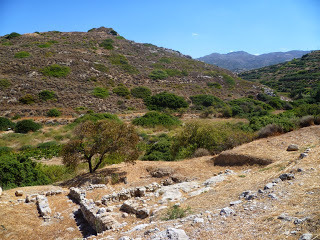
Sitia might not be blessed with tranquil beaches, but it is rather spoiled when it comes to ancient sites. So much so that you don’t even have to pay to get in to Petras, a place that was occupied continuously from 2500 to 1400 BC. It had earlier been used for production of purple dye from shells in the early Minoan period. In later times wine and pottery were made here. The remains reveal an ancient two-storey warehouse which once had massive pillars covered in red plaster, and storage rooms for rows of huge jars.

It was here they found the best preserved hieroglyphic archive of Minoan Crete – the inventory tablets and official seals of the palace. Also, one of those mundane details that really bring ancient sites to life, they found cups and bowls that the personnel used for taking snacks to work. Their lunchboxes.
Later, we walked across the town and out towards the headland to the west, a scrappy area with oddly expensive-looking houses and unfriendly faces. Coming back to town, I saw people swimming off the rocks near the entrance to the harbour; just below the road, it wasn’t beautiful but might be a good place to let Lisa go in the sea, since she wasn’t allowed on the town beach.
‘Apogoreveteh!!’ shouted nasty women at the water’s edge, waving their arms. They could at least have been nicer about it, since I clearly didn’t know. Upset, I wondered if I'd made a mistake staying. What I couldn’t understand is that the place seemed full of dogs! Wherever we went, stray dogs followed us or yappy dogs barked from balconies. Maybe that was why they had to be banned from the sea.
I walked down the seafront past busy cafes, wondering where we’d be welcome. Eventually I sat down in the corner of a rakadiko, like an ouzeri but for raki, called Oinodeion, and drank some good local wine, and felt better. I ordered makarounes, soft local pasta, with anthotyro, comforting and delicious.

Small islands like Tilos are relaxing, I think, because of the simplicity: you’re not faced with lots of choices of where to go – and you can go everywhere if you like, on foot, with nature all around you. In Sitia I find myself staring endlessly at the map with all its different roads, and thinking about what do when I rent my genuine Minoan car, and how much traffic there will be. Then I wonder about putting it off for a day.
Passing a souvlaki place, I get waylaid by Drunken Yiannis, who insists on buying me a beer. I’ve barely escaped when I’m stopped in the street by an old Greek who lives in Sweden and insists on telling me he’s still good friends with his children’s mother. It’s beginning to feel a bit like speed dating, Sitia-style.
I then get lost, but by way of bonus find myself at a fantastic little traditional cheese shop called Kouvarakis that sells yoghurt, staka and a typical Sitian cheese called xygalo. Xygalo, according to their leaflet, is 'a cheese dating back to Minoan times' (hmm, that's a seriously old cheese). Made of goats' or sheep's milk, it's light and sourish-tasting - the name comes from the word for acidic - it was mentioned in Pliny's Natural History.
The shop owner tells me the Sitia food festival starts on Friday evening. Things are definitely looking up.
... Tune in for more of my Cretan adventure tomorrow!
Minoan: minoan_cars@yahoo.gr
Cheese shop: www.kouvarakis.gr
Since none of the taxis at the port in Rhodes would take a dog (or maybe they didn't like the look of me...), I walked with my backpack – plus Lisa’s dog food, as if she was going to eat any of that stuff – across the old town and all the way to the vet’s.
It was just as well: he found a length of sharp dry grass deep piercing her ear drum. He put her to sleep while he buried his arm in her ear to pluck it out. His office managed to book us a cab that would take me and a very groggy dog back to the port. She was still sleepy when the ferry arrived, and I had to carry her on board and up all the steps to the top deck dogs’ accommodation. The vet had just weighed her: twenty kilos.
The Preveli reminded me how lucky we are to have the good ship Diagoras. No cosy couches here; and the dogs’ pens were cold and noisy and far away from human contact. There were just two dogs, shaky and shivery… It was hard to leave Lisa there for the night. I wished I could put her back to sleep.
But it was warm and sunny when we arrived, early morning, in Sitia.

My work in Crete involved taking the bus straight to Ierapetra on the south coast. But according to the bus company, there was no way that was going to happen unless I bought a cage for Lisa and put her in the hold with the luggage. There are indeed days when Lisa deserves to be locked up in a cage…. But not when she was on antibiotics and painkillers for a healing ear drum, had just endured a cold night on the Preveli and been welcomed to Sitia by some hard-looking canines.
The Preveli was going back to Rhodes that afternoon. I had a few hours to decide whether to try staying in Sitia for three days, or go straight back, another twelve hours on the ship and all for nothing. Finally a car rental office called Minoan (I wondered if they were authentic Minoan cars?) came to our rescue.
When I walked into his office, weary from hefting my backpack to the bus station and all around town after a fairly sleepless night, Michalis smiled at Lisa and she jumped up and put her two front paws on his desk. Out of kindness (and not just to get us out of his office, I’m sure) he rang around and managed to find a hotel that would take us. It turned out to be a great hotel, right in the middle of the beachfront of town, called the Itanos. So I decided we’d stay. The nice young chap at reception fed Lisa an almond.
Is Lisa a spoiled dog, staying in one of the best hotels in town?

I think we’re all spoiled in Tilos. I found myself looking at the lovely long beach on the edge of Sitia and thinking, ‘Well, it would have been nice if they hadn’t built a road next to it.’ Not just any road, but one full of speeding lorries. But we braved it that afternoon to have a look at Petras, a kilometre east.

Sitia might not be blessed with tranquil beaches, but it is rather spoiled when it comes to ancient sites. So much so that you don’t even have to pay to get in to Petras, a place that was occupied continuously from 2500 to 1400 BC. It had earlier been used for production of purple dye from shells in the early Minoan period. In later times wine and pottery were made here. The remains reveal an ancient two-storey warehouse which once had massive pillars covered in red plaster, and storage rooms for rows of huge jars.

It was here they found the best preserved hieroglyphic archive of Minoan Crete – the inventory tablets and official seals of the palace. Also, one of those mundane details that really bring ancient sites to life, they found cups and bowls that the personnel used for taking snacks to work. Their lunchboxes.
Later, we walked across the town and out towards the headland to the west, a scrappy area with oddly expensive-looking houses and unfriendly faces. Coming back to town, I saw people swimming off the rocks near the entrance to the harbour; just below the road, it wasn’t beautiful but might be a good place to let Lisa go in the sea, since she wasn’t allowed on the town beach.
‘Apogoreveteh!!’ shouted nasty women at the water’s edge, waving their arms. They could at least have been nicer about it, since I clearly didn’t know. Upset, I wondered if I'd made a mistake staying. What I couldn’t understand is that the place seemed full of dogs! Wherever we went, stray dogs followed us or yappy dogs barked from balconies. Maybe that was why they had to be banned from the sea.
I walked down the seafront past busy cafes, wondering where we’d be welcome. Eventually I sat down in the corner of a rakadiko, like an ouzeri but for raki, called Oinodeion, and drank some good local wine, and felt better. I ordered makarounes, soft local pasta, with anthotyro, comforting and delicious.

Small islands like Tilos are relaxing, I think, because of the simplicity: you’re not faced with lots of choices of where to go – and you can go everywhere if you like, on foot, with nature all around you. In Sitia I find myself staring endlessly at the map with all its different roads, and thinking about what do when I rent my genuine Minoan car, and how much traffic there will be. Then I wonder about putting it off for a day.
Passing a souvlaki place, I get waylaid by Drunken Yiannis, who insists on buying me a beer. I’ve barely escaped when I’m stopped in the street by an old Greek who lives in Sweden and insists on telling me he’s still good friends with his children’s mother. It’s beginning to feel a bit like speed dating, Sitia-style.
I then get lost, but by way of bonus find myself at a fantastic little traditional cheese shop called Kouvarakis that sells yoghurt, staka and a typical Sitian cheese called xygalo. Xygalo, according to their leaflet, is 'a cheese dating back to Minoan times' (hmm, that's a seriously old cheese). Made of goats' or sheep's milk, it's light and sourish-tasting - the name comes from the word for acidic - it was mentioned in Pliny's Natural History.
The shop owner tells me the Sitia food festival starts on Friday evening. Things are definitely looking up.
... Tune in for more of my Cretan adventure tomorrow!
Minoan: minoan_cars@yahoo.gr
Cheese shop: www.kouvarakis.gr
Published on November 24, 2013 11:50
November 9, 2013
Rhodes in November
 For some time now, I've been fascinated by cafe culture in Rhodes. It seems to be an essential, vibrant part of the local scene, especially for the under-forties. And yesterday I found further proof.
For some time now, I've been fascinated by cafe culture in Rhodes. It seems to be an essential, vibrant part of the local scene, especially for the under-forties. And yesterday I found further proof. Turning a corner into a usually empty pedestrian street just up the hill from the New Market, just north of the Old Town, I was stunned to find not one brand new cafe, but four. It was about 2.30 p.m., the break in the middle of the working day, summer was back after a brief hiatus, and each cafe was busy.
Turning a corner into a usually empty pedestrian street just up the hill from the New Market, just north of the Old Town, I was stunned to find not one brand new cafe, but four. It was about 2.30 p.m., the break in the middle of the working day, summer was back after a brief hiatus, and each cafe was busy.

I asked a waiter if it was true, that these were all new, and he grinned and confirmed they'd all opened in the last few months, with a little shrug as if to say, 'You know, that's how it is here...' Pop-up cafes. And I wouldn't be surprised if they're all owned by the same guy.
 Usually trendy Casa La Femme was closed for refurbishment, and the Yacht Club Cafe was practically deserted. The four cafes that fill a stretch of Dimitriou Theodoraki Street are the place to be - for now.
Usually trendy Casa La Femme was closed for refurbishment, and the Yacht Club Cafe was practically deserted. The four cafes that fill a stretch of Dimitriou Theodoraki Street are the place to be - for now. And the place not to be is the Old Town, which is wonderful.
The Street of the Knights is bare, doorways open to reveal lush gardens.
 This time of year is when I love Rhodes. It's warm and sunny, but quiet. Most of the tourist shops and restaurants are closed. You can see the walls. Only once did a waiter hurry up from his chair in a cafe and say 'Yes please!' But my backpack was empty, gradually filling up as the day progressed with shopping.
This time of year is when I love Rhodes. It's warm and sunny, but quiet. Most of the tourist shops and restaurants are closed. You can see the walls. Only once did a waiter hurry up from his chair in a cafe and say 'Yes please!' But my backpack was empty, gradually filling up as the day progressed with shopping.
Down by the now-peaceful harbour, across a calm, deep blue sea, the mountains of Turkey were clear in every small detail, layers and layers of mountains stretching off into the distant haze. A man cycled by slowly wearing cut-offs and flip-flops; a snorkeller dived down into the sea, his flippers forming a V. Cats wandered among the rocks, soaking up the sun.
 Back in the Old Town, in backstreets, occasional groups of men sat outside drinking and listening to Greek songs played loud, some sitting on old crates that bowed under their weight. It was a holiday, and people were celebrating, and shouted hello. I had a smile on my face all day.
Back in the Old Town, in backstreets, occasional groups of men sat outside drinking and listening to Greek songs played loud, some sitting on old crates that bowed under their weight. It was a holiday, and people were celebrating, and shouted hello. I had a smile on my face all day. 

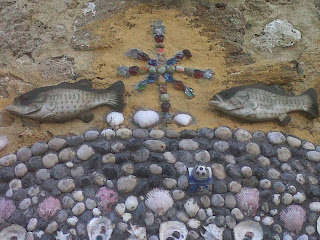
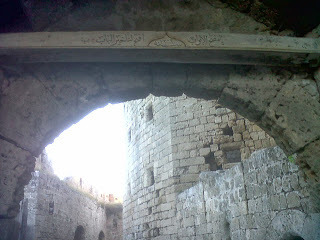
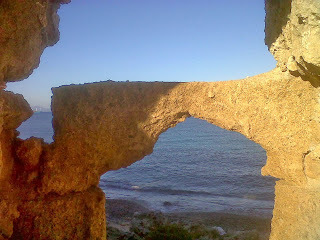
Published on November 09, 2013 01:19
November 2, 2013
November in Megalo Horio - photos
Yesterday morning, I arrived back in Tilos after a few days in Athens. 'Does it feel like coming home?' someone asked me last night. Yes, it does, but it also makes me think: 'Wow, do I live here?!' It was a classic rosy-fingered dawn, all the colours and shapes of the cliffs making me feel giddy all over again.
Sourcebooks, who will be publishing the North American edition of Falling in Honey in March 2014, have come up with a beautiful cover concept for the book (see right) but are not sure yet about the photo and are looking around for something a little more obviously Greek. I thought I'd send them some photos of Tilos for ideas, and I took my camera out. Not that any of these are cover photos - but I thought I'd share with you how beautiful Megalo Horio looks this warm, sunny Saturday in early November.




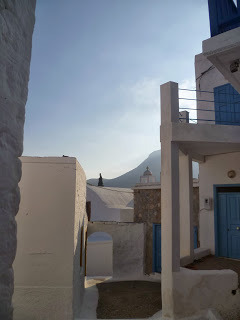
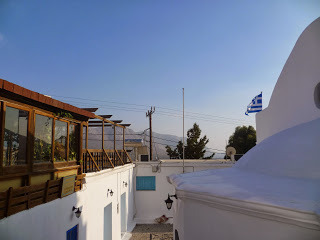
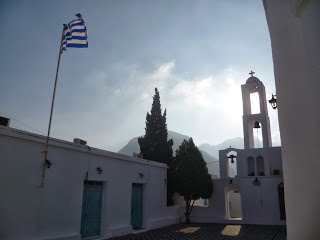


Thank you to everyone for the messages you've sent by email and posted here following my last blog about Dimitri.
Sigh, what has happened to Lisa? She has transformed into a naughty puppy again over the last two days, destroying anything she can get her mitts on (or teeth into). I have to run...
Kalo meena - have a good month!
Sourcebooks, who will be publishing the North American edition of Falling in Honey in March 2014, have come up with a beautiful cover concept for the book (see right) but are not sure yet about the photo and are looking around for something a little more obviously Greek. I thought I'd send them some photos of Tilos for ideas, and I took my camera out. Not that any of these are cover photos - but I thought I'd share with you how beautiful Megalo Horio looks this warm, sunny Saturday in early November.









Thank you to everyone for the messages you've sent by email and posted here following my last blog about Dimitri.
Sigh, what has happened to Lisa? She has transformed into a naughty puppy again over the last two days, destroying anything she can get her mitts on (or teeth into). I have to run...
Kalo meena - have a good month!
Published on November 02, 2013 07:48
October 26, 2013
Goodbye Dimitri

Yesterday, 25 October, was a sad day. Our friend Dimitris Kassandrinos, head teacher of the secondary school in Tilos, left the island for the last time.
Probably sometime in the afternoon of 24 October, he was in his car going up to or coming down from the monastery of Ayios Panteleimonas with a German woman called Ute, who had recently become his girlfriend, when the car went over the side of a steep cliff, and both were killed. The authorities are investigating how it happened. He was noticed missing yesterday morning, and a local who keeps goats up that road saw something. A rescue team came in by helicopter and during the afternoon the two bodies were recovered from the deep ravine.
Dimitris, originally from Volos, was around 50 years old and had lived in Tilos 11 years; he was a chemistry and biology teacher and in recent years was head teacher of the secondary school. He told me he wished I'd used his real name in my book. He visited his family in the area around Volos during school holidays and his mother came to stay during the winter.
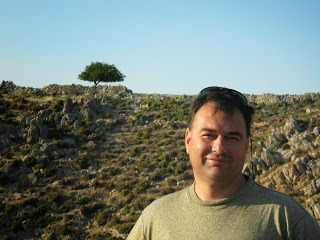
When in Tilos, throughout the year, Dimitris spent most afternoons in the sea, fishing for octopus. When I first came to Tilos, he took me out snorkelling and introduced me to the hidden beaches and underwater life of the island, and drove me up to the monastery to see the sunset over the sea, a view he loved. Who knows, perhaps it was his last. Someone who had spoken to Ute said they were happy together.
Yesterday, as the sun went down, they were being taken down to Livadia. In the evening, under a sky full of bright stars, the Milky Way clearly visible, a boat came to take them away.
Today, 26 October, he would have been celebrating his name-day. It being a Saturday, he would undoubtedly have been out in the sea somewhere. I walked up the monastery road to see where it happened - a beautiful place - and then down to Plaka, to the little bay on the promontory. I'd brought my snorkel with me. I saw anemones with their wavy orange hair, a small eel's ribbon-body curling around a rock, and even a beautiful fikopsaro with a tail so fine and silver it looked like a needle. And all the sea creatures he showed me how to find...
Kalo taxidi
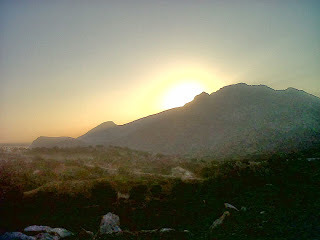
Published on October 26, 2013 00:15
Goodbye Dimitris
 Yesterday, 25 October, our friend Dimitris Kassandrinos, head teacher of the secondary school in Tilos, left the island for the last time. It was a sad day.
Yesterday, 25 October, our friend Dimitris Kassandrinos, head teacher of the secondary school in Tilos, left the island for the last time. It was a sad day.Probably sometime in the afternoon of 24 October, he was in his car coming down from the monastery of Ayios Panteleimonas with a German woman called Ute, who had recently become his girlfriend, when the car went over the side of a steep cliff, and both were killed. The authorities are investigating how it happened. He was noticed missing yesterday morning, and a local who keeps goats up that road saw something. A rescue team came in by helicopter and during the afternoon the two bodies were recovered from the deep ravine. In the evening a boat came to take them away.
Dimitris had lived in Tilos 11 years; he was a chemistry and biology teacher and in recent years was head teacher of the secondary school. Around 50 years old, he was divorced, with two late-teenage daughters in Athens, whom he saw during school holidays, as well as his mother in his home town of Volos. Apparently Ute was about the same age, with a son aged around twenty, and they were happy together.
When in Tilos, throughout the year, Dimitris spent most afternoons in the sea, fishing for octopus. When I first came to Tilos, he took me out snorkelling and introduced me to the hidden beaches and underwater life of the island, and drove me up to the monastery to see the sunset over the sea, a view he loved. Who knows, perhaps it was his last.

Today, 26 October, he would have been celebrating his name-day. It being a Saturday, he would undoubtedly have been out in the sea somewhere.
Kalo taxidi…

Published on October 26, 2013 00:15
October 19, 2013
Tales from Megalo Horio

The kantina is closed and locked up, moved off Eristos beach in preparation for winter storms; the weather is mild; the busy days of travelling and moving house are over. In the words of Italian yoga teacher Anna, who was kindly giving classes this month: 'Now relax the body, and breathe normally.'

I've been somewhat distracted by the beautiful view from my new office - and particularly by the little church, the ekklisaki, just below my window. I've always rather liked it, and now I'm a little obsessed. Inside, there's an oil lamp burning, and frescoes covering much of the walls and ceiling.
The village of Megalo Horio is built into a hillside that's littered intriguingly with stones from many centuries of inhabitation. The house that we are renting, although the front additions are quite modern, has a stone archway on the main part of the house, with '1868' painted over, and the courtyard has a couple of old millstones lying about. Doorways down the alley have what look like early Christian crosses above them, while others have Turkish inscriptions.

I took Lisa for a walk up to the castle a couple of days ago. She was indulgent about my need to take photographs and inspect the fading frescoes of old chapels, now exposed to the elements, on the way up. She noted that I didn't need quite so many photo stops on the way down. It's surprising what a steep old path it is; it was clearly meant to make access by invaders as tough as possible. People used the fortress at the top to retreat to in times of danger, but lived lower down the slopes, between the castle and the current village.
From the clouds, it was clear that rain was coming, but there was enough bright sunlight to make for spectacular views, as always, from the medieval walls built over an ancient acropolis.

(They don't build things like they used to, it seemed on the way down...)

Yesterday, having finished my deadlines for the week, I thought I'd pop down to the museum to see if Vicky knew anything about the church. Of course she did. She confirmed that it is dedicated to Ayios Ioannis Theologos, St John the Theologian, whose monastery is in Patmos.

As to its age, she said it was 'post-Byzantine', or medieval. I thought it must be old, I said, because it's built on top of one of the old walls made of massive stones. 'The wall is Hellenistic,' said Vicky, 'from the time of Alexander the Great.'

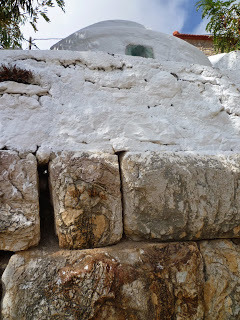
'All these little churches were privately owned,' she continued. 'That one was in the family of Stelios's father's uncle, Apostolis Logothetis. He was a teacher, and during the Italian occupation he was persecuted because he taught Greek secretly. It was against the law to teach Greek, or even to speak it on the main street here.' She gestured to the road through Megalo Horio, underneath the museum.
'Because the Greek language was forbidden, and only Italian language was taught, gradually the parents took their children out of school. When I met my mother-in-law, she was illiterate.'
Up the steps to where we were standing walked Polixeni Logothetou; in her late eighties or so, always dressed in black and with a few friendly words to offer, she was carrying her wooden walking stick in a jaunty fashion over her shoulder, a bag of vegetables hanging off it. Vicky told her I was asking about the little church, and she confirmed its connection to Apostolis Logothetis. 'Polixeni knows,' said Vicky, 'she is one of Stelios's father's godparents - one of seven.'
'Ah, the old folks, they're all gone now!' said Polixeni with slightly misty eyes, then proceeded on her way to cook lunch.
So the little church continues, having seen much history. This morning just after eight, one of the village ladies stopped to say hello outside our house, crossing paths with Menelaos who was carrying bags of shopping and getting a morning welcome from Lisa the affectionate semi-Labrador. 'Where are you going, neighbour?' asked Stelios. 'Well, I'm going to Theologos, and then to do some jobs...' She disappeared inside the church.
Shortly after, I was pondering the strange things you hear shouted across the alleys and rooftops here from time to time ('The mulberries are at the house!' - surely some secret code...) when Vicky arrived to give me some decorations for the house, old embroidered cloths, handmade. As she left, she pointed to a stone by our gate, one I've been thinking looks like a carved chunk of old marble with a hole for a wooden gate-post. 'This is ancient,' she said, and continued in a hurry to go and open the museum.
Well, the sun is shining in a clear sky, so we must be off to enjoy the day...
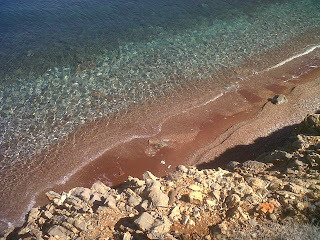
***
NB: For those interested in houses to rent or buy in Megalo Horio, I'm gradually putting some information on the News page of the blog.
****
My Facebook photos of the walk we did today!
https://www.facebook.com/jen.barclay.33/posts/10151967376785803
Published on October 19, 2013 00:18
October 4, 2013
Moving, and a Museum
Hard as it is to believe, this week we are leaving the house next door to the honey factory. A few weeks ago, I tasted this summer's honey, and it was delicious. Sadly, I'll no longer be able to crack jokes about life being sweet when you live next door to the honey factory...

When I first came here two and a half years ago, this house was just perfect for me. But now there's a fisherman who's been known to clomp in trailing seaweed from his wellies, dripping bloody saltwater from a plastic bag full of freshly cleaned fish while I'm in the middle of editing a book, or on a Skype call to a client; now there's a half-Labrador sprawling herself across the sofa. Life has not stood still, and I wouldn't want it any other way.
I've been keeping an eye out for a bigger place for the last year, but nothing felt quite good enough to draw me away from the pleasures of living in the middle of nowhere, with no noise outside at night that isn't a bird or insect, and no lights to detract from the millions of stars up above.

Then during the summer, Antonis from Megalo Horio asked me if I'd take some photos of a house he had in the middle of the village and put them online to see if he could find a buyer or tenant. I looked around and thought, hmmm. The problem with the current house is that it's basically all one big room with a mezzanine, and call me a wimp but I don't like being woken up at fisherman o'clock by cigarette smoke. The house in the village still has a view of the sea and hills, but it also has... an office for me. This could make life in the Barclay-Logothetis household rather less frosty on certain days. And being in the middle of Megalo Horio should bring a whole new set of stories.
So we're moving, though in true Tilos style, it's happening slowly, as we have to wait for Yianni the internet technician to return from some travels and connect us up in the new place. I can't complain as I was away the weeks before, in Crete and then Athens.
In fact, Stelios and I went to Athens together, leaving Lisa with her cousin Ari, a German shepherd or 'wolf-dog' who lives with Tilos's well-loved former taxi drivers, Nikos and Toula. Our mission was to see doctors; all those tests I've been having are to investigate why I've miscarried three times in the last two years. We had appointments with a few doctors, to get information and perhaps choose one to go forward with.
The week was sometimes difficult, of course, but it was an important thing for us to go through as a couple. And we enjoyed relaxing together - something we haven't had time to do all summer, since BC (Before Cantina). We found a room at the lovely Phidias hotel in Thissio, so peaceful you'd hardly know you were in central Athens.

On the last day I had to give blood in the morning and then prepare for possible investigative surgery in the afternoon, which meant not consuming anything all day until we saw the doctor. I am not good at being hungry and thirsty, especially when nervous. While wandering around Athens looking for distractions, we came across a museum of folk art/decorative arts; not usually our thing, perhaps, but for 2 euros a person we decided to give it a try.
Although the museum sadly lacked explanations and details of the customs involved, exhibits included local dress from many parts of Greece, including Tilos. Most fascinating for me were the elaborate, heavy, metalwork of the women's head-dresses, some originating from the Dodecanese, and the intricate carving of everyday objects like distaffs for weaving.

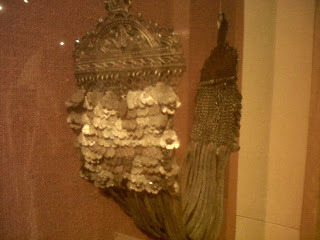



There was also a whole section devoted to one of my favourite Greek artists, Theofilos, who painted everyone with a smile and a moustache.
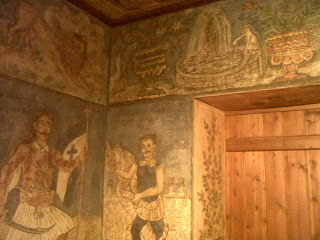
The last doctor we saw - with a moustache but not much of a smile - definitely wasn't for me, so I didn't have the surgery with him after all. He showed a bizarre lack of understanding of what it might be like for a woman to be still crazily trying to have a child at the age of 44. At least he provided me with a nice emotional opening to a story I've just drafted this morning, which the Daily Mail have expressed interest in publishing (fingers crossed).
It's very windy outside today, but brilliant sunshine, and the first rain of autumn on Monday has made everything feel fresh and alive. Time to go and walk the lovely half-Labrador Lisa, and maybe pack or unpack some boxes.
**
PS We just walked my bike up to the new house - Lisa is delighted that it's no longer 35 degrees outside - and found a lovely welcome note from a reader who's in Tilos this week. Thank you! Here are some more photos of/from the new house... That's a lemon tree in the courtyard!





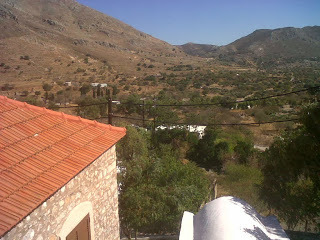


Published on October 04, 2013 04:10
September 15, 2013
Three Nights on Nisyros: To Be Continued...
We travel into the sunset, the huge fiery orb dropping slowly into the sea. Soon after, the Diagoras ferry is docking at Mandraki, Nisyros. Years ago, I stayed in the middle of the village, but this time I walk up to the first hotel overlooking the water. At Three Brothers, Antonis quickly tells me his best price for a room, and I beat him up an extra three euros to have a view of the sea, over a bamboo garden, with a church to one side and a hillside filled with prickly pear bushes behind. I swing the doors open to listen to the waves.

What I remember best about Nisyros is the way the waves crash up on the rocks and the walls and houses of Mandraki. I wander out and find them – but also the monastery lit up at the end of the village on the clifftop, and a brilliant crescent moon above. Big wooden balconies almost touching one another across tiny alleys, washing hanging to dry, groups of women sitting on the doorsteps, chatting, plant pots in every conceivable space. I'd forgotten how difficult it was to find the square, hidden in the winding alleyways.

At kafeneion Antrikos, two older ladies in almost identical blouses and cardigans sit side by side on a bench, hands crossed in their laps, hair nicely set and beatific smiles, soumadas in glasses in front of them. (Soumada's the local almond cordial.) One of them gets up and walks away from the busy cafe to answer her mobile phone, shouting to someone who is clearly hard of hearing: Stin Nisyro! Ena nisi! S'ena nisi! Nisi! Nai, ena nisi!... ‘I’m in Nisyros! An island! On an ISLAND! An ISLAND! Yes, an ISLAND!’ The kafeneion's slogan is ‘Varda Stenahoria’, an old phrase meaning something like ‘Sadness begone!’ The music is rebetika. Despina asks my name and Antrikos tells me he’s visited England – Liverpool of course, when he worked on the ships.


I think I'm on my way home to bed, but halfway back, appropriately enough, end up at a bar called συνεχίζεται, or 'To be Continued'. Set on a quiet part of the sea wall, it used to be an 'after' bar, but as of this year has started making the most of its fabulous setting, and now stylishly squishy chairs look out at the waves crashing up, lit up by pretty lanterns. Dimitris, the owner, makes me an apple cocktail I probably didn't need, and tells me about the island.
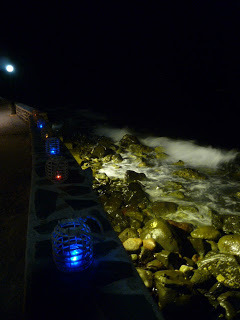
Next morning, I'm at Koklaki beach as the sun comes over the top of the cliffs. Black pebbles, volcanic rocks, wild and natural; a view of the green side of Yiali island – half pumice, half obsidian.
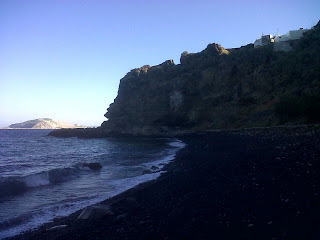




About 25 turtles are nesting this year, I learned from posters last night, on the totally natural Liess beach. I decide to walk there, but en route am curious to see the old spa of Loutraki, with its ‘sodium chloride sulphurous natural curative baths’ according to the sign. It’s amazingly peaceful and I get talking to Georgos, 73, sitting outside, who tells me he’s been watching the fish in the little harbour there. Originally from these islands, he went to Australia as a young man. His father sent him there to get his brother back, but he stayed; when I asked if he’d come back home much, he counted off the precise year of every trip over fifty years.

I'm glad I didn't rent a scooter as walking, I see birds of prey soaring over the slopes above, and at Palli the sea is so still in the harbour you can see fish glinting silver in the deep. Beyond Palli are volcanic stone walls in dark greys and reds.


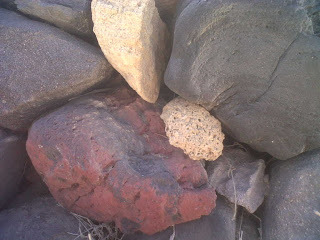
A road seemingly to nowhere stretches around the island. Pigs and cows, a warm ripe fig stolen from behind a fence. Finally beach again – roped off areas protect turtle nests. Cliffs are layers of pumice. Kit off, swim, read and fall asleep to sound of sea on empty stretch of beach. Disturbed by noise – what’s that? Ah, goats reaching for caper bushes on the cliffs above me, dislodging stones.

Ready to leave, I'm curious to take a peek to see what’s over the headland – not expecting to find cows being herded from beach to hillside.


I eat that night at Koklaki restaurant – for the wall paintings and the waves crashing up just below. Fish soup is recommended. What fish does it have, I ask. 'Fish for soup.' Silly question. It's delicious, and I can even have a small Greek salad with Nisyros goat’s cheese, which is superb – tasty, hard and crumbly. There are nice little chocolate treats at the end, home made. I watch the moon sinking as I finish the wine. Then I can't resist a nightcap at the kafeneion, and get chatting to friendly folks there. Even though I didn't rent a scooter from him, Manos buys me a second raki I definitely didn't need.
 By the time the bus has climbed to the rim of the caldera next morning, I’m already feeling queasy and hoping the brakes are checked regularly. Nikia is breathtaking – stunning views across the blue sea to one side (and Tilos), and on the other side all the way down into the volcano.
By the time the bus has climbed to the rim of the caldera next morning, I’m already feeling queasy and hoping the brakes are checked regularly. Nikia is breathtaking – stunning views across the blue sea to one side (and Tilos), and on the other side all the way down into the volcano. 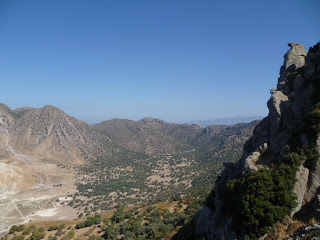
After an educational visit to the volcano museum, I relax in the utterly beautiful plateia - you can't call it a square because it's round. At kafeneion ‘The Gate’, I have kanellada, a cinnamon drink, with rice pudding. Panayiotis, whose family has run the café for 42 years, regales me with stories such as that of the local man who had many children. 'When you asked him how many children he had, he’d say fifteen – except for those outside the marriage!’


The village’s mini-market, where I hoped to pick up supplies for my walk, has just closed; so I have to settle for the most delicious moist slab of pear and chocolate cake from the restaurant near the museum. I need sustenance as I'm about to go 'off-piste', and follow a path goodness knows where. I wander through old abandoned settlements, and after my eyes have been opened by the museum, no stone is left unexamined: scoria or basalt?

I can’t resist a trip down into the volcano, to feel the sulphurous steam rising up in the crater.



There's a café, so I go to stock up on water and find, unexpectedly, beautiful handmade soaps on sale, created using the natural herbs of the island. Dreadlocked Ellie, who makes them up in Emborio, helps me choose a path back to Mandraki, following a monopatiwhich she rightly says I will lose and find and lose again, until I reach the dirt track near Stavros monastery, and wind my way back around the other side of the island past little chapels and farms, as the sun starts to turn everything silver and gold.
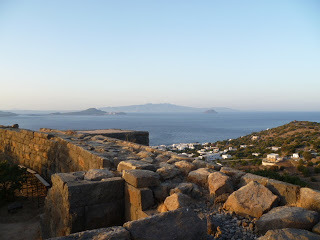
Just before Mandraki, I stop at the ancient defence wall, now restored; up here somewhere are ancient cemeteries, where folks were cremated with vessels of oil, wine, honey, figs and olives. Path down into the village, ending up under the monastery of Panayia Spiliani, where I jump into the sea.
Later, beautiful music spills out of a doorway, and I wander down steps to find To Kazanario, a wine bar/ouzeri in an old building whose huge arches open out into a garden bordering the villagers' allotments. They have local wine – hard to find on sale – smooth and dry, amber-coloured, delicious. And tiny, delicate calamari from just across the water in Kos, served with potatoes sprinkled with herbs, and a salad with a huge slab of feta. I realise the music is now live, and when I go to watch the group of young people sitting around playing for fun, I’m invited to join them. It’s another late night.
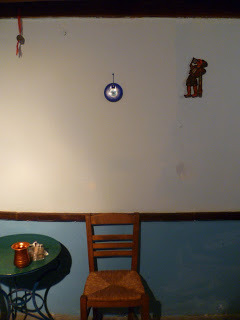
One of the brothers is serving breakfast in the morning, but keeps going down to the water to check his fishing line, and brings in little fish to feed the cats.
At the archaeological museum, I must have dozed off, sleep-deprived, listening to the long list of things that were prohibited – photos, bags, copying down more than a few words of display text – and thus missed or not understood the prohibition against sketching. So my enjoyment of the museum is spoiled - not only can't I study the pieces by drawing them for my diary, but I'm condescendingly reprimanded. But in the end they have done me a favour, as leaving swiftly I head instead for a couple of hours at Koklaki beach, swimming and dozing and examining strange rock formations.
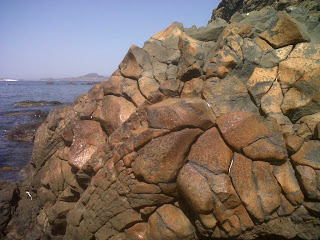
By 2 pm when I drag myself away, equilibrium restored, the ferry ticket offices are closed, except for one, where I explain to the friendly lady that I’d sort of been hoping I’d left it too late and would have to stay. ‘I shouldn't have sold you a ticket, eh?!’ she joked. Sitting with a cool glass of soumada at the port café, I glimpse my ferry just about to take off without me, and make a mad dash to catch it before it pulls away.

But there's no need to worry - after all, Nisyros is less than an hour from Tilos by boats that run all year round.
As we approach Tilos, my new friends Andreas and Luisa ask me to tell them about it, and as I point out parts of the island (that road leads up to the monastery, and there is Plaka beach, with its peacocks, and that's Skafi beach, near my house, and up there is an abandoned village, with an amazing music bar...) I realise I'm excited and extremely lucky to be going home to Tilos.
And more new friends welcome me back to Tilos at the kantina, asking me to sign my book! Thank you to our Swedish and Scottish friends, and to Deborah and Maggie and Eileen... Those who fell in the honey with Tilos a long time ago, and those just beginning.
My discovery of Nisyros - and Tilos - is 'to be continued'.
Published on September 15, 2013 01:59



